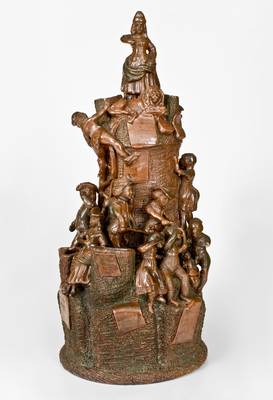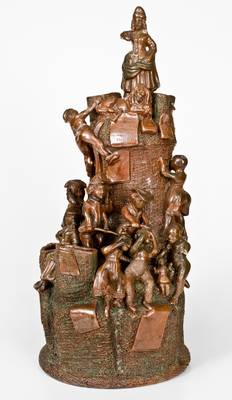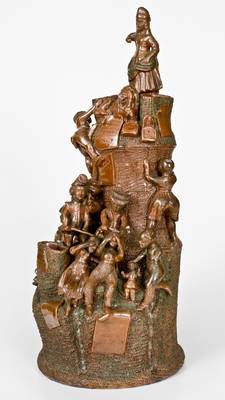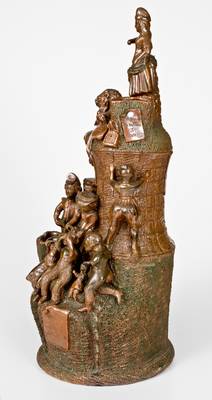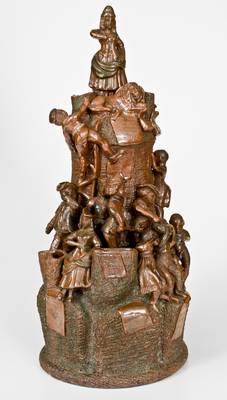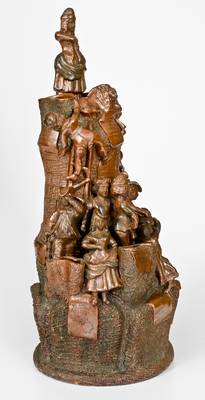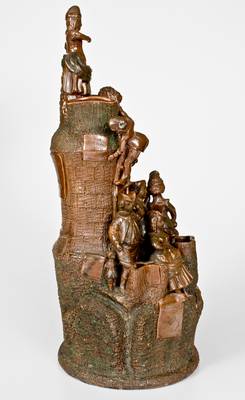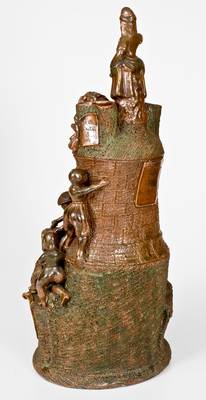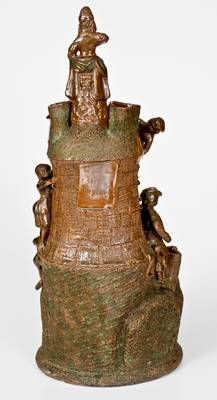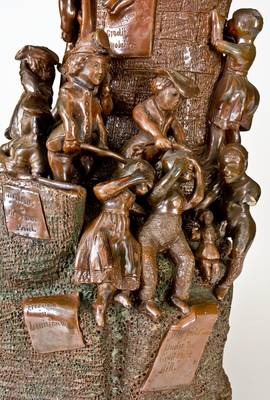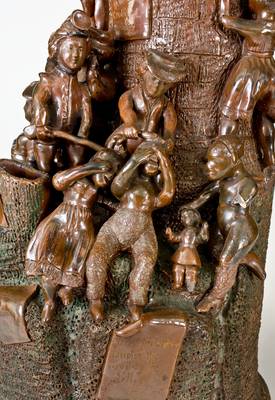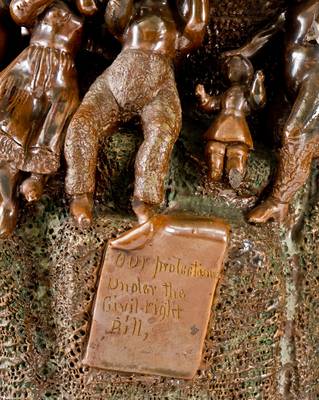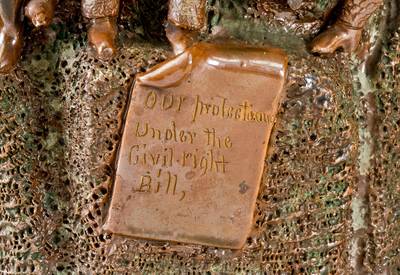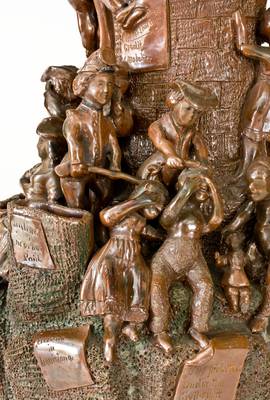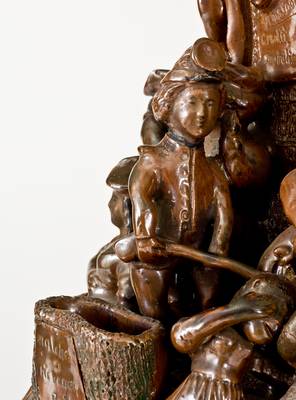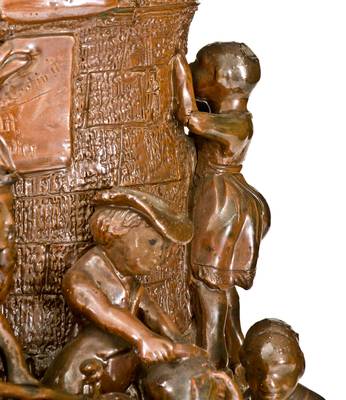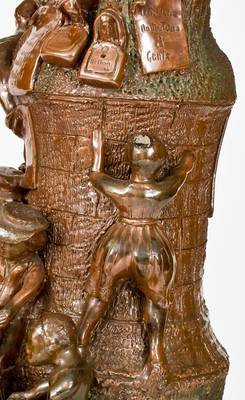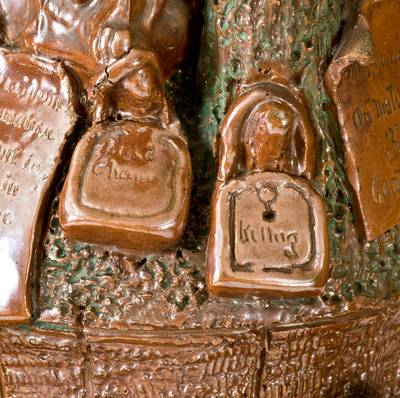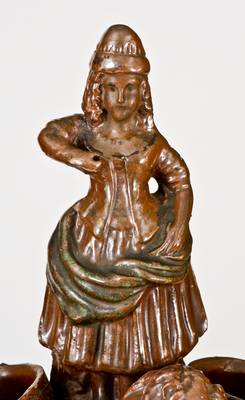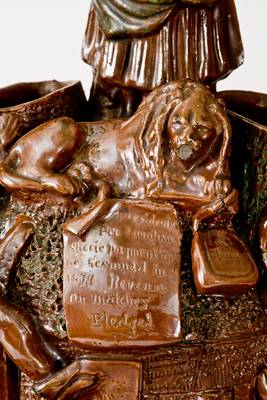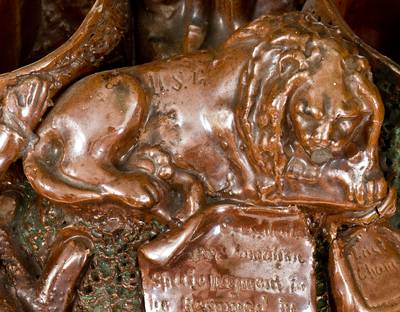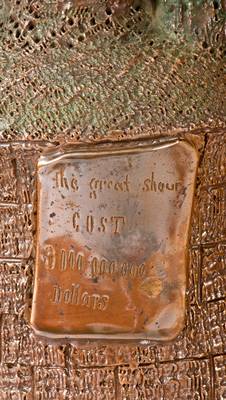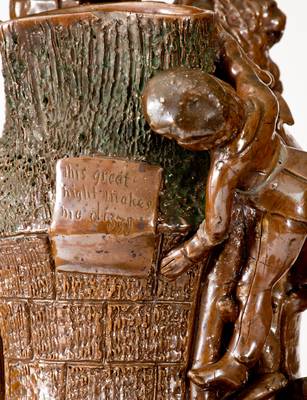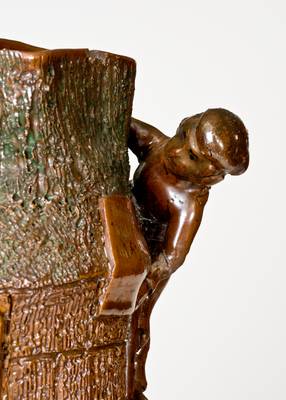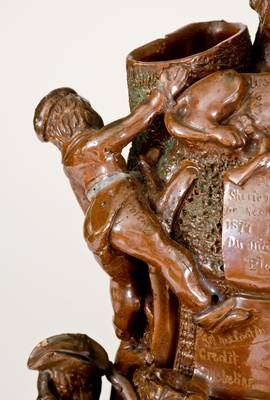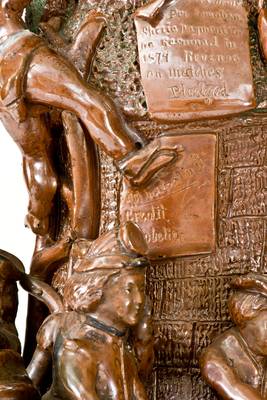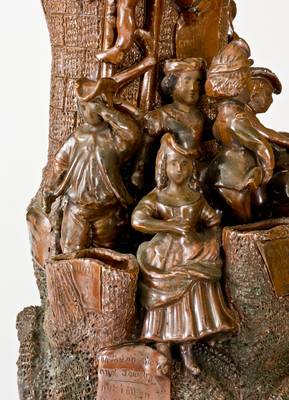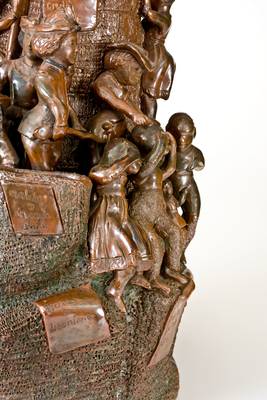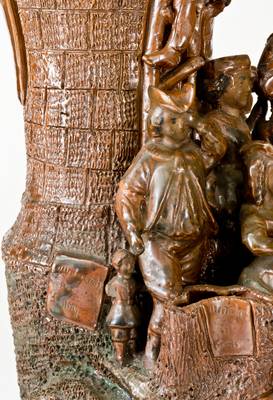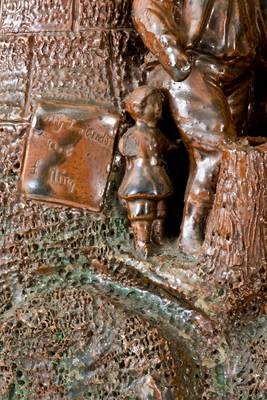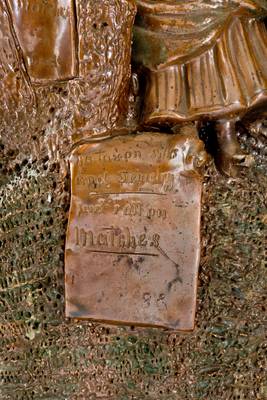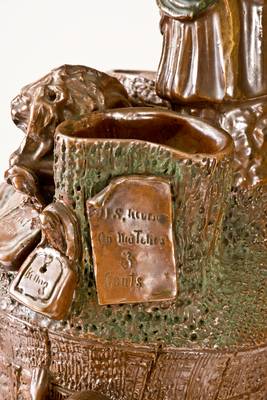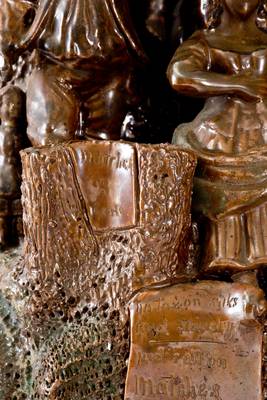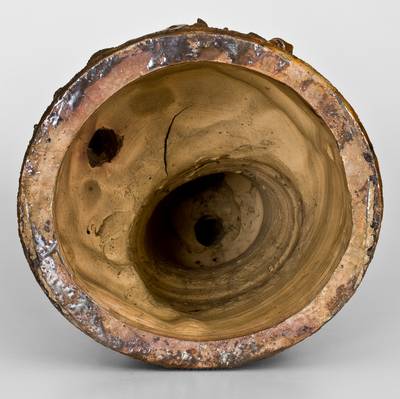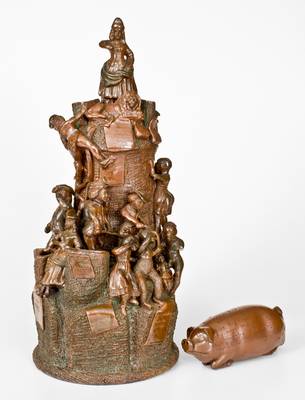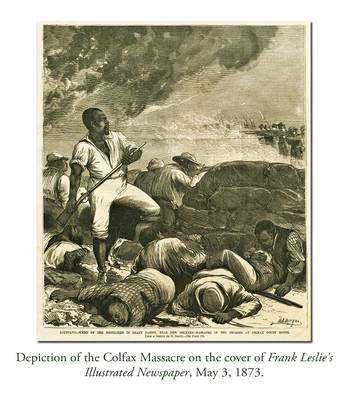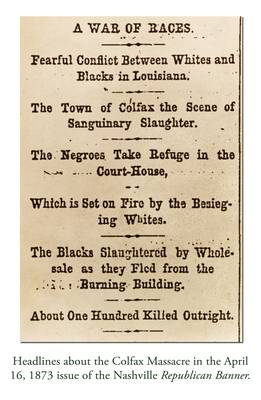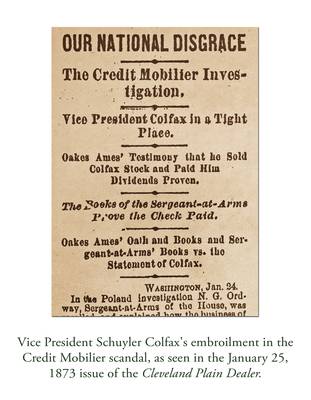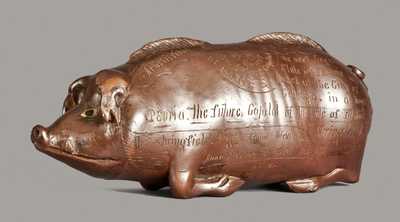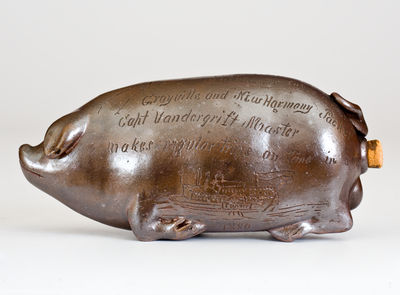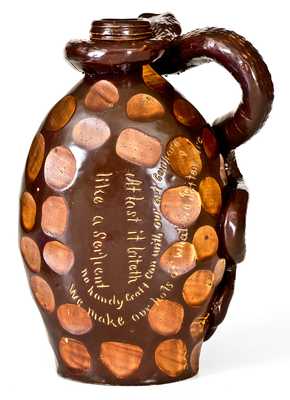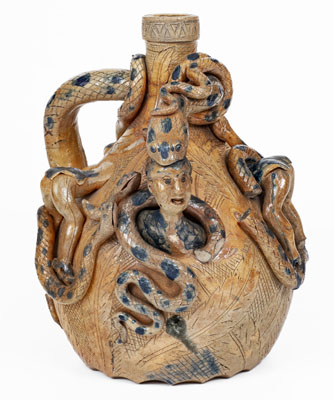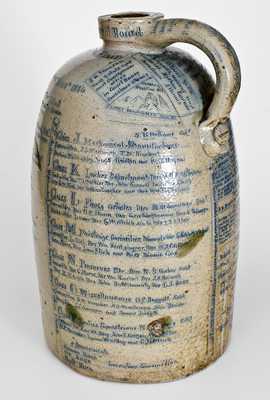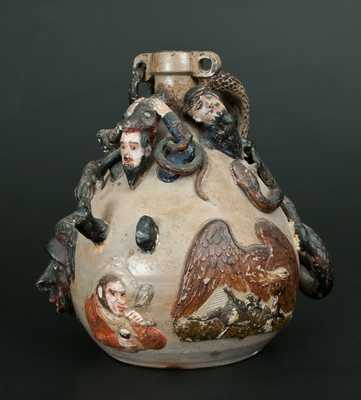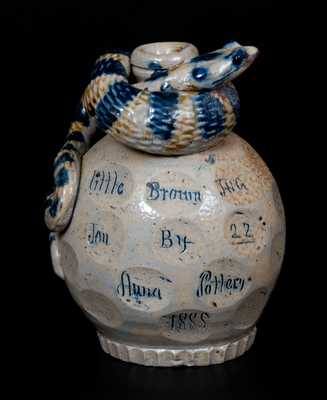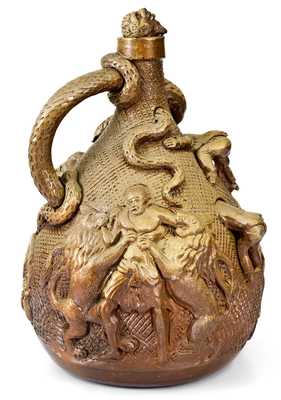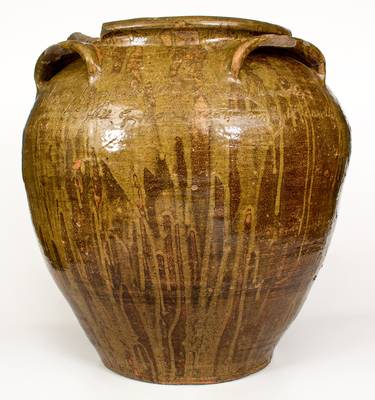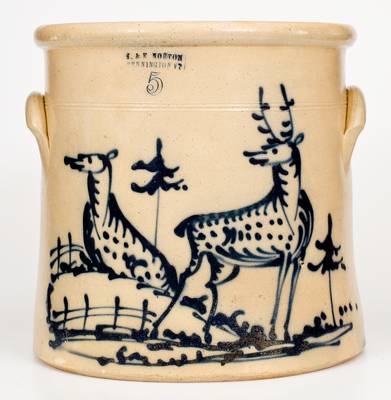Highly Important Anna Pottery Stoneware Liberty Monument with Applied Figural Decoration, Wallace and Cornwall Kirkpatrick, Anna, IL, 1873, a large work composed of connected, wheel-thrown cylinders brimming with molded, hand-modeled, and applied clay figures. Several applied clay broadsides appear throughout the sculpture, incised with various slogans. Surface covered in an Albany slip glaze with glass runs to base and green-glazed highlights to the upper body. This recently-discovered folk sculpture by two of the nation's most celebrated ceramicists is perhaps the most historically significant, racially progressive, and politically charged example of American pottery known.
Potted in the shape of a monument with hand-incised bricks emanating from a rustic mound, this previously-unknown form relates to Anna Pottery's iconic aquarium castles. Serving as a social commentary on the American Reconstruction Era, the primary subject of the sculpture is the Colfax Massacre, today viewed as the largest lynching in American history. On Easter Sunday in 1873, as many as 153 African-Americans were slain at the Grant Parish Courthouse, located in Colfax, Louisiana. Republican black militiamen had occupied the courthouse as a result of a hotly-contested Louisiana gubernatorial election, one marked by fraud on the part of white supremacist Democrats. Despite surrendering, the militiamen were killed at the courthouse at the hand of a white Democrat mob, which included ex-Confederates armed with rifles and a small cannon. The Kirkpatricks' sculpture depicts this tragedy in vivid detail, with two white figures, armed with a rifle and pistol, one wearing a Confederate forage cap, pressing their weapons against a black man and woman, who are covering their eyes in anguish and fear. A third black figure kneels with his arm on a child, in an attempt to shield her from the violence. The Kirkpatricks, in their typical sarcastic fashion, have placed a plaque below the figures reading, "Our protection under the Civil right Bill," referring to the "Civil Rights Act of 1866," the first U.S. Federal law stating that citizens of all races had equal protection under the law. A second broadside beside the figures reads "Freedom in Louisiana." Another figure, a black woman related to those found on Anna's shoo fly jugs, attempts to scale the tower towards a padlock, or possibly a ballot box, inscribed "Kellogg," for William Pitt Kellogg, the Republican gubernatorial candidate of 1872. (Fraud was rampant during this election. Among the obstacles faced by blacks was a requirement for voters to prove an age of 21 to vote, despite the fact that former slaves were never given birth certificates.) Even higher on the tower is a molded figure of a reclining lion, inscribed "USG," for President Ulysses S. Grant. Lions produced from the same mold can be found on much smaller Anna works. In this case, the lion serves as a symbol of Grant's strength and nobility as the leader of a recovering nation. A second padlock or ballot box, inscribed "Last / Chance," hangs over the lion's paw, stating, in plain terms, that Grant is the last chance for creating a successful and virtuous country. The tower's peak is surmounted by a molded figure of the goddess Liberty, in classical dress, wearing a liberty cap, with outstretched arm. An original piercing in her raised hand suggests she may have been designed to allow the owner to insert a miniature wood-and-cloth American flag, if so desired. This figure, the personification of the concept of liberty in its purest form--one free from the influence of politics--is the only figure depicted above Grant (the lion). The depiction of a black woman ascending a tower to vote serves as an allegory for the difficulties African Americans faced within the Reconstruction era voting system. However, more broadly speaking, her ascent can be seen as an attempt at reaching an even greater goal at its apex: Liberty. The Colfax Massacre has gained significant recognition in this century as a pivotal moment in our nation's history.
A second very different story is illustrated on the left side of the tower. Here we see a well-dressed family with father holding his hand against his head in despair. A figure climbing a ladder above the family, identified by the inscription "Colfax" on his leg, represents Vice President Schuyler Colfax (1823-1885), who served from 1869 to 1873 under the Grant administration. A broadside to the left of Colfax reads, "this great hight(sic) makes me dizzy," referring to the challenge of having the second highest office in the land. A second broadside, through which Colfax is literally stepping, reads, "got his foot in it / Credit Mobelier." In 1872-1873, several stockholders in the Union Pacific Railroad formed a construction company called Credit Mobilier of America to build the Eastern portion of the Transcontinental Railroad. Credit Mobilier overcharged the construction by $44 million, which went to Union Pacific executives, who used $9 million of it to bribe high-ranking congressmen. Vice President Colfax was also implicated in the fraud, essentially ending his political career. A broadside to the right of the family below Colfax reads "my friends are falling," referring to the economic collapse of the Union Pacific Railroad and its investors in the wake of the scandal. It is interesting to note that the name, Colfax, plays a role in both events depicted on the tower: one being the name of a Vice President and the other being the name of an ill-fated town in Louisiana--one representing the powerful and the other representing the powerless.
A total of four wheel-thrown match safes are contorted and applied to the object's base and top, indicating that this creation was more than decorative. Perhaps it was prominently displayed in a bar, lounge, or other place of business where smoking would have been frequent. A number of the monument's applied broadsides reference the Revenue Act of 1862, designed to help fund the Civil War, in part, through excise taxes on various items, including matches. Ever wary of government, the Kirkpatricks poke fun at the expense and absurdity of this match tax. One broadside reads, "U.S. revenue / on matches / 3 cents." Another proclaims, "no tax on silks / and jewelry / put i[t] all on / matches." Two others state, "matches / revenue / paid." A large broadside directly below the lion declares, "Presidents / proclamation / Specie payment to / be resumed in / 1879 revenue / on matches / Pledged." Another large broadside on the tower's reverse distills the Kirkpatricks' view of the Civil War into one simple slogan: "the great show / COST / 3 000 000 000 / Dollars." Describing the war as a "show" and listing its exorbitant price (largely paid for by taxes), the Kirkpatrick brothers are decrying the war as something theatrical, expensive, and largely ineffective in leading to a truly free nation.
The Anna Pottery Liberty Monument stands as one of the most ambitious works in all of 19th century American ceramics, both in terms of its craftsmanship as well as its message. Its grand scale, meticulous detail, and bold imagery, both expositional and symbolic, rank it as a masterwork in several mediums of American art. Provenance: Recently-surfaced in the Western United States. Figure of Colfax broken and reglued. Large loss to arm of kneeling male figure. One child figure missing arm. Loss to foot of another child figure. Minor in-the-firing flaws. Minor chips. H 23" ; Diam. (at base) 9".

